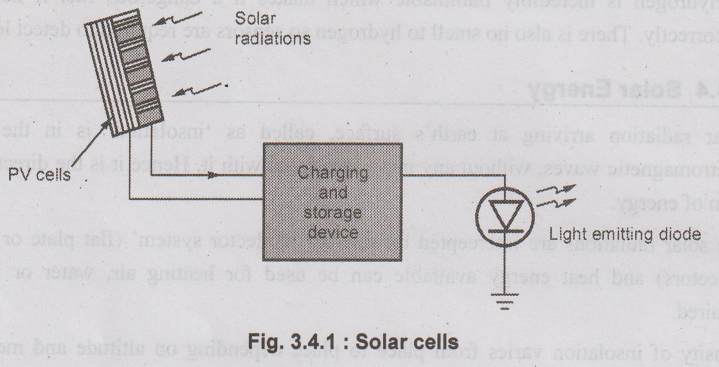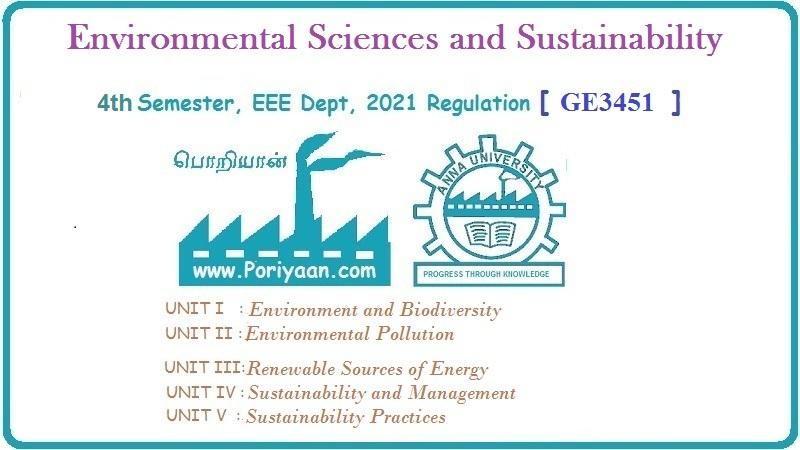Environmental Sciences and Sustainability: Unit III: Renewable Sources of Energy
Solar Energy
Working Principle, Diagram, Use, Advantages, Disadvantages
• Solar radiation arriving at earth’s surface, called as ‘insolation’ is in the form of electromagnetic waves, without any mass associated with it. Hence it is the direct and pure form of energy.
Solar Energy
•
Solar radiation arriving at earth’s surface, called as ‘insolation’ is in the
form of electromagnetic waves, without any mass associated with it. Hence it is
the direct and pure form of energy.
•
The solar radiations are intercepted by suitable ‘collector system’ (flat plate
or parabolic collectors) and heat energy available can be used for heating air,
water or liquids as required.
•
Density of insolation varies from place to place depending on altitude and
metrological conditions.
•
A solar thermal device consists of collector, distribution (circulation)
system, storage and insulation.
•
Solar energy is trapped by collector and by simple heat transfer techniques,
heat energy is transferred through water, air or other suitable fluid.
•
For more temperature and efficiency, number of collectors and parabolic
collectors are designed.
Harvesting
/ Harnessing Solar Energy
•
The techniques for collecting, converting and using solar energy is called as
harvesting or harnessing. Some important solar harvesting devices are :
1.
Solar cells / photovoltaic cells / PV cells
2.
Solar heat collectors
3.
Solar water heaters
4.
Solar cooker
5.
Solar water pumps
Solar
cells or PV cells
•
Solar cells are actually p-n junction diode working on photovoltaic technology
i.e. there is direct conversion of solar radiation into Direct Current (DC)
electricity.
•
Semiconducting materials are most effective in this process of conversion.
•
The light energy is converted into equivalent DC energy by solar cells (PV
cells). This energy is then stored in some device (battery); so that it can be
used whenever needed.

Uses
1.
PV cells are commonly used in calculators and watches.
2.
PV cells provide power to satellites.
3.
Small electric appliances like - solar lamp, radio, street lighting.
4.
Industrial applications - water pumping, wheather stations.
Solar
heat collectors
•
A solar heat collector is used for heating modern houses in eastern countries.
A solar home or building is designed to collect the Sun's heat through South
facing glass windows.
•
In solar-heated buildings, sunspaces are built as large heat absorbers. The
floors are made of tiles or bricks that absorb heat throughout the day, they
release the heat at night when weather is cold.
Uses
1.
Solar heat collector used in cold countries for making domestic or commercial
places hot.
1. Use of Solar Energy
•
Solar energy can be used for following purposes :
1)
Air or water heating for industrial processes, use of solar pumps for water
pumping.
2)
Distillation and desalination of water (solar still).
3)
Hot water for cooking, cleaning and similar uses, (solar water heater).
4)
Electricity generation by using photovoltaic cells.
5)
Solar drying for food and vegetable products for cottage and small scale
industries.
6)
Other uses like solar cookers, lamps, lanterns, battery charger, etc. for
household purpose.
7)
Solar cars/vehicles have been designed.
2. Advantages of Solar Energy
1.
Solar energy is freely available.
2.
It does not produce ash, fumes and noise pollution hence it is clean, noiseless
and environment friendly.
3.
It saves money in long run.
4.
It is renewable form of energy
5.
Non polluting. No wastes created by its use.
6.
Has lot of domestic applications. Hence advantageous for huge Indian
population.
3. Disadvantages of Solar Energy
1.
Initial cost is very large.
2.
Energy should be stored in batteries.
3.
Large space is needed for installation.
4.
Energy generated is dependent on solar intensity
5.
High temperatures cannot be achieved (> 40 °C). Efficiency of collector goes
down with increase in temperature.
6.
Clouds affect the amount and quality (efficiency). Hence may not be available
when required.
Environmental Sciences and Sustainability: Unit III: Renewable Sources of Energy : Tag: : Working Principle, Diagram, Use, Advantages, Disadvantages - Solar Energy
Related Topics
Related Subjects
Environmental Sciences and Sustainability
GE3451 ESS 4th Semester | 2021 Regulation | 4th Semester EEE Dept 2021 Regulation
